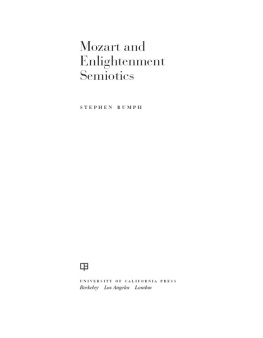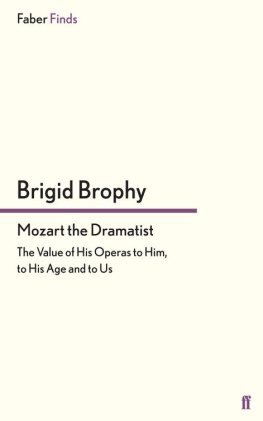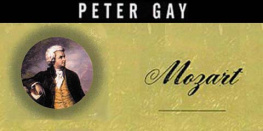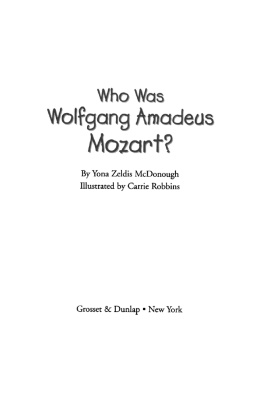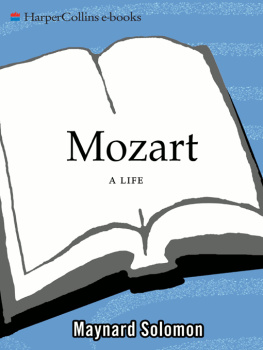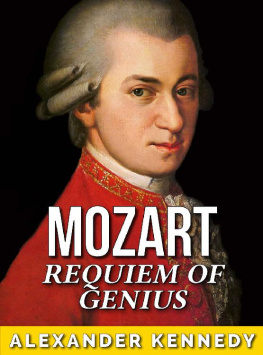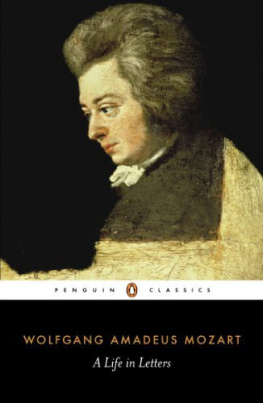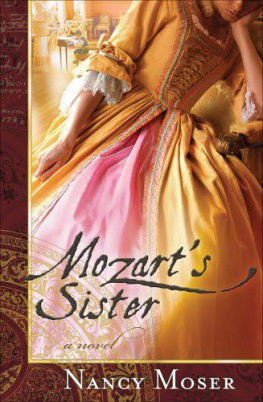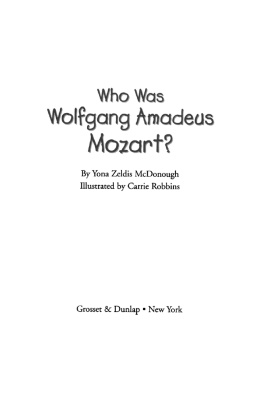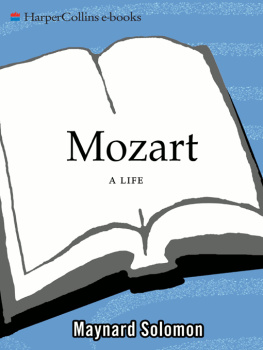Mozart and Enlightenment Semiotics
The publisher gratefully acknowledges the generous support of the Ahmanson Foundation Humanities Endowment Fund of the University of California Press Foundation.
The publisher also gratefully acknowledges the generous contribution to this book provided by the University of Washington.
Mozart and Enlightenment Semiotics
STEPHEN RUMPH

University of California Press, one of the most distinguished university presses in the United States, enriches lives around the world by advancing scholarship in the humanities, social sciences, and natural sciences. Its activities are supported by the UC Press Foundation and by philanthropic contributions from individuals and institutions. For more information, visit www.ucpress.edu.
University of California Press
Berkeley and Los Angeles, California
University of California Press, Ltd.
London, England
2012 by The Regents of the University of California
Library of Congress Cataloging-in-Publication Data
Rumph, Stephen C.
Mozart and enlightenment semiotics : Stephen Rumph.
p. cm.
Includes bibliographical references and index.
ISBN 9780-520260863 (cloth : alk. paper)
1. Mozart, Wolfgang, 17561791Criticism and interpretation.
2. Music18th centuryHistory and criticism. 3. MusicSemiotics.
4. Enlightenment. I. Title.
ML410.M9R86 2012
780.92dc23
2011020890
Manufactured in the United States of America
20 19 18 17 16 15 14 13 12
10 9 8 7 6 5 4 3 2 1
In keeping with a commitment to support environmentally responsible and sustainable printing practices, UC Press has printed this book on Rolland Enviro100, a 100 percent postconsumer fiber paper that is FSC certified, deinked, processed chlorine-free, and manufactured with renewable biogas energy. It is acid-free and EcoLogo certified.
In memory of my mother,
Carolyn Oleman Smith (19302009)
I cannot write poetically; I am not a poet. I cannot arrange my words so artfully that they reflect shadow and light; I am not a painter; I cannot even express my feelings and thoughts through gestures and pantomimes: I am not a dancer. But I can do it with the sounds of music; I am a Musikus.
Wolfgang Amadeus Mozart, letter of 8 November 1777
Contents
Musical Examples
.
.
.
.
.
.
.
.
.
.
.
.
.
.
.
.
.
.
.
.
.
.
.
.
.
.
.
.
.
.
.
.
.
.
.
.
.
.
.
.
.
.
.
.
.
Acknowledgments
This book has benefited from the insights and critiques of many keen minds. I learned much from conversations with Michael Spitzer, Richard Will, Laurence Dreyfus, Marshall Brown, Matthew Head, Peter Hoyt, Lawrence Zbikowski, and Jacqueline Waeber. Robert Hatten kindly read portions of the manuscript, as did the late Raymond Monelle. Wendy Allanbrook also found time to offer generous, at times appropriately stern, comments on my work. I have appreciated the opportunity to preview chapters at Stanford University, the University of British Columbia, Duke University, the University of Oxford, and the Centre for Research in the Arts, Social Sciences and Humanities (CRASSH) at the University of Cambridge. Special thanks are due to my anonymous reviewers, whose unsparing comments prompted me to clarify many a vague idea and hazy passage.
Among my colleagues at the University of Washington, Robin McCabe, Judy Tsou, Larry Starr, JoAnn Taricani, Aine Heneghan, George Bozarth, Jane Brown, Joel Durand, and Shannon Dudley deserve special thanks. I have cherished the ongoing friendship of Berkeley acquaintances, especially Peter Mercer-Taylor, Steve Swayne, and my advisor, Joseph Kerman. Richard Taruskin has remained a trusted mentor, unflagging in his encouragement and advice. I have enjoyed stimulating conversations with James Hepokoski, Stephen Hinton, Nick Matthews, Carlo Caballero, Dean Sutcliffe, Richard Wattenbarger, Sherry Lee, Vera Micznik, and Caryl Clark and have valued the openness and generosity of spirit of Elaine Sisman, James Webster, Mary Ann Smart, Karol Berger, Anna Maria Busse-Berger, Bob Judd, and many other musical scholars. Outside the academy, I have treasured the opportunity to work with outstanding coaches, conductors, and directors, from whom I have learned invaluable lessons about Mozart, opera, and musical meaning. A short list must include Jonathan Khuner, Erich Parce, Dean Williamson, Katherine Cathcart, Christophe Chagnard, the late George Shangrow, Jeffrey Simon, Gerard Schwarz, Fred Carama, and the late Richard Miller.
Mary Francis and her team at University of California Press once again made the publication process an effortless joy. Mary has been a dream editorencouraging, wise, tactful, efficient. Many thanks also to Eric Schmidt, Suzanne Knott, Rolf Wulfsberg, and Mary Ray Worley.
I am grateful to Music and Letters and the Journal of the Royal Music Association for kind permission to reprint, respectively, .
Many wonderful friends have accompanied me during the writing of this book, including Laura Kakis Serper, Philip Mote, Rebecca Martin, Arne Lim, Ken Knutzen, Paul Spinrad, and Timothy Dunne. To Marilia Roman voc linda mais que demais. Deep thanks and love go to my stepfather, Chalmers Smith; my father and stepmother, Charles Rumph and Shirley Johnson; my daughter, Nastasja; and my numerous siblings, inlaws, nieces, and nephews, among whom I must single out my stepsister, Sarah Smith.
This book is dedicated to the memory of my mother, Carolyn Oleman Smith, a woman of legendary warmth and compassion, as well as a superb collaborative pianist. She was my first and best musical companion, and not a day passes that her memory does not inspire me.
I close with a quote that reveals my deepest acknowledgment and which seems fitting for a book on signs: And the Word became flesh and dwelt among us. To Him be glory both now and forever. Amen.
Introduction
In 1717 Alphonse Costadau, an obscure Dominican friar, published the first installment of his Trait des signes. He set himself an ambitious task: My plan has been nothing less than to assemble in a single corpus the principal signs that serve to express our thoughts and that have been instituted for each purpose, whether to form and entertain a perfect human society or to serve the pleasures and commodities of life, signs that, so far as I know, have only been discussed piecemeal. The Trait eventually filled twelve volumes and covered a formidable range of material. Costadau cataloged linguistic, gestural, sculptural, pictorial, religious, military, and sartorial signs; he even analyzed the signes diaboliques through which necromancers communed with demons. His first volume also featured a long chapter on musical signs from antiquity to the present.
Costadaus project may surprise readers accustomed to thinking of The famous treatises of the Abb Du Bos, Charles Batteux, James Harris, Moses Mendelssohn, Gotthold Ephraim Lessing, Edmund Burke, and Johann Gottfried Herder all rely upon a careful analysis of signs and representation. Finally, the rampant speculation on language gave a mighty boost to the semiotic enterprise.
Enlightenment sign theory has attracted much attention since the 1960s. The simultaneous publication in 1966 of Noam Chomskys Cartesian Linguistics and Michel Foucaults Les mots et les choses
Next page
